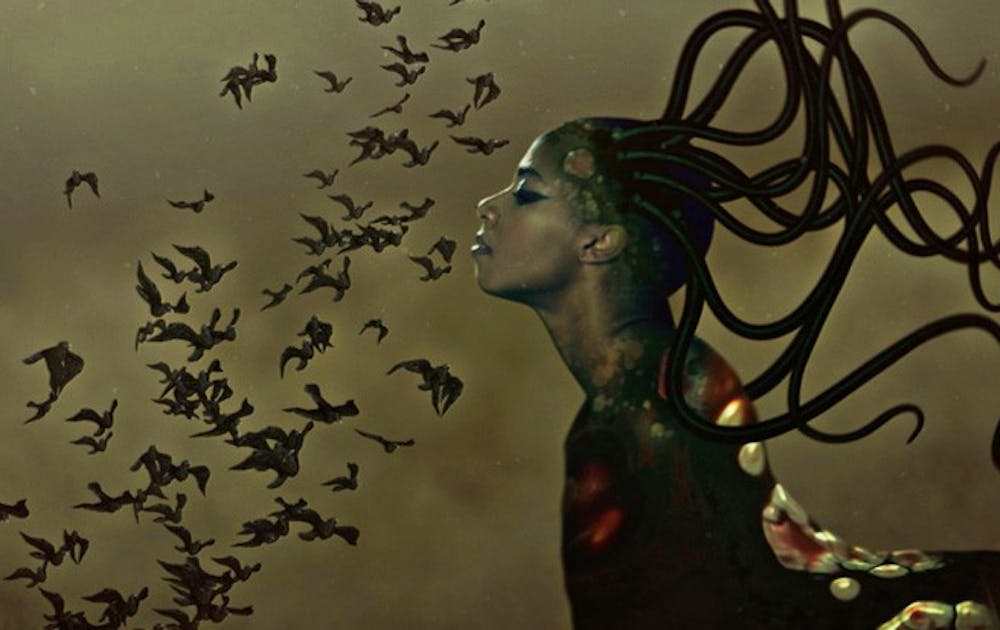An otherworldly landscape has appeared at the Nasher Museum of Art. Wangechi Mutu: A Fantastic Journey opens today, welcoming visitors into a lush landscape of multi-sensory experience. At the gallery entrance, a life-sized womanlike creature with nonhuman limbs stares down from the wall, cloth tree roots literally protruding below her. Inside the gallery, a field of hanging orbs seems at once like a hundred bouncing balls and like a new kind of ecological landscape.
The piece, Suspended Play Time, references the soccer balls children in Kenya often make from trash bags, said Wendy Livingston, Manager of Marketing and Communications at the Nasher. Born in Kenya, Mutu now lives and works in Brooklyn, New York, but she references her home country throughout her work.
A Fantastic Journey gathers pieces that have never before been shown together, both from private collections and major museums such as the Museum of Modern Art in New York and the San Francisco Museum of Art. The exhibit features large-scale mixed-media collages, site-specific sculptures and three films. The collages are eerily beautiful, each one a window into an ethereal world of jellyfish horizons and mini-mushroom patches. Distinctly female figures—perhaps not quite human—gaze out from behind tall grass, ant-sized motorcycle creatures and kittens underfoot. Within the figures’ faces hide lizards and amputated body parts culled from fashion magazines and pornography.
The female body and eroticism is a clear theme in Mutu’s work. The figures arch and crouch in a manner reminiscent of pornographic poses. Plump lips are exaggerated and long legs are emphasized—yet the figures exude strength and sadness rather than sexual desire. The overarching feeling of the exhibit is not an erotic one—though Mutu uses eroticism as a critique, the feeling is one of a textural, otherworldly landscape.
The Nasher does not frequently have solo exhibitions, making A Fantastic Journey exceptional in this regard. Trevor Schoonmaker, the Patsy R. and Raymond D. Nasher Curator of Contemporary Art at the Nasher, has been friends with the artist for over a decade, which helped bring the exhibit to fruition. Schoonmaker contrasts A Fantastic Journey with the exhibit Barkley L. Hendricks: Birth of the Cool from 2008, which was a retrospective, whereas A Fantastic Journey is a mid-career review. The show will serve both as an opportunity for fans to see her work collected and as a chance for new viewers to be introduced to Mutu’s vision.
“It takes a lot of trust for a solo show,” said Livingston. And the show benefits from that trust, as evidenced by the pages on display from Mutu’s sketchbooks—shown for the first time ever. “She feels these are very personal,” explained Schoonmaker. “It took some effort to make her comfortable enough to share.” The drawings grant a rare glimpse into the artist’s practice. Primarily line drawings, the sketches show the evolution of form manipulation in Mutu’s process that ends with the complex fantastical collages.
Also on display is a new acquisition by the Nasher. Family Tree is a series of mixed-media collages depicting the family line of the creation of the world. The collages demonstrate the passing on of visual elements, as if the familial genes were being inherited. The mythological portraits are more abstract than the other work in the exhibit, incorporating surprising collage pieces, like lizards hidden in a face.
Mutu’s work is extremely complex in terms of craftsmanship, composition and content. In addition to exploring sexualization of the female figure, Mutu’s work examines issues of race and power. This is exemplified by figures holding up other figures, Schoonmaker explained. In particular, Misguided Little Unforgivable Hierarchies depicts a figure crouching in the grass, head tipped back and mouth open as a smaller figure stands on her back and arches to meet the first figure. On top is a small half-woman, furry monkey-like creature. Protruding from around the crouching figure’s leg is the dark silhouette of phallic shapes, referencing the banana skirt of ’20s-era African-American erotic dancer Josephine Baker, explained Schoonmaker. The piece is layered in meaning, shrouded in controversial imagery on multiple levels. It connects to the history of oppression and marginalization experienced by the exploitation of the African continent and the diaspora of its people, but also references the related issue of globalism through the use of contemporary sexualized media images.
The show also serves as the premiere of Mutu’s first animated video, a collaboration with musician Santigold, which was commissioned by the Nasher Museum. “They have a lot in common,” said Schoonmaker. “[Santigold’s work is like] collage with sound.” The piece is like Mutu’s collages coming to life: a woman morphs into the figurehead on the prow of a glowing shivering ship, complete with wheels turning and steam spewing. Amputated arms poke out, perhaps the lost souls of the slave trade or those crushed by the relentless progress of industrialization, waving as the whole mass heaves to a unique soundscape. The video is emblematic of Mutu’s work, which provides compelling examinations of historical issues that continue to plague us today.
The Nasher Museum of Art is the first venue for Wangechi Mutu’s touring exhibition. Wangechi Mutu: A Fantastic Journey will be on view through July 21.
Get The Chronicle straight to your inbox
Signup for our weekly newsletter. Cancel at any time.

